After an underwhelming opening day performance from hosts Qatar against dark horses Ecuador, the second day of the 2022 FIFA World Cup began with a thrilling 6-2 win from an impressive England against Iran. Many expected Senegal and the Netherlands to follow suit, however, the AFCON champions and Europe’s in-form side competed in a cagey affair.
There has been an emphasis on the detrimental effects that losing the opening fixture in an international tournament can cause. With a Sadio Mané-less Senegal and a Netherlands squad with a severe lack of World Cup experience, elements of this cautious approach appeared, creating a tight contest.
As favourites to top Group A and enjoy a run deep into the tournament, the Netherlands had an opportunity to make a statement against a well-respected Senegal. However, there was also an aura that this game was a must-win for Oranje. Dropped points would put even more pressure on their second game against the resolute Ecuador, with Senegal expecting to beat Qatar a couple of hours earlier.
Two late goals from PSV Eindhoven attacker Cody Gakpo and substitute Davy Klaassen got the job done for Louis van Gaal’s men, despite Senegal’s valiant efforts. Aliou Cissé’s Lions of Teranga will be aiming to bounce back with a win against Qatar to set up a crucial decider against Ecuador.
In this tactical analysis, we will look at the tactics of Senegal and the Netherlands which saw the African champions largely go stride-for-stride with an Oranje side unbeaten in fifteen games.
Lineups
Aliou Cissé lined up in a 4-3-3/4-2-3-1 hybrid with the glaring absentee that is Bayern Munich’s Sadio Mané. AS Monaco’s Krépin Diatta was selected as the replacement for the 2022 Ballon d’Or runner-up, although the former Liverpool forward has irreplaceable star quality. Regularly appearing on the right wing at club level, Diatta was heavily involved on the right flank against the Netherlands with his ball-carrying and pace. However, Watford’s Ismaïla Sarr was a persistent danger that terrorised the Dutch defence on the left with Boulaye Dia in central areas.
Everton’s Idrissa Gana Gueye would occasionally join the attackers from midfield, making much-needed movements into the box from a midfield trio that is primarily known for their defensive work. Behind Gueye in Senegal’s Premier League midfield was Nottingham Forest’s Cheikhou Kouyaté and Leicester City’s Nampalys Mendy. Mendy operated as the pivot player for the Lions of Teranga, but his ability to progress possession was dramatically minimised by the Netherlands’ Cody Gakpo. Kouyaté provides further duelling strength to Senegal’s midfield but was eventually replaced by Marseille’s Pape Gueye due to injury.
Senegal’s use of their full-backs have been essential to their recent success, and they were key to their performance against the Netherlands. At right-back, Youssouf Sabaly of Real Betis frequently advanced into the final third in possession. Sabaly provided the most expected threat in the match, creating three chances whilst also contributing well defensively.
RB Leipzig’s Abdou Diallo had a more measured approach at left-back, remaining deeper to facilitate Sabaly’s surges forward. When AS Monaco’s Ismail Jakobs replaced Diallo, Jakobs matched Sabaly’s attacking intent, winning all of his duels and helping to progress and gain territory for Senegal. Chelsea goalkeeper Édouard Mendy’s involvement in the Netherlands goals was questionable.
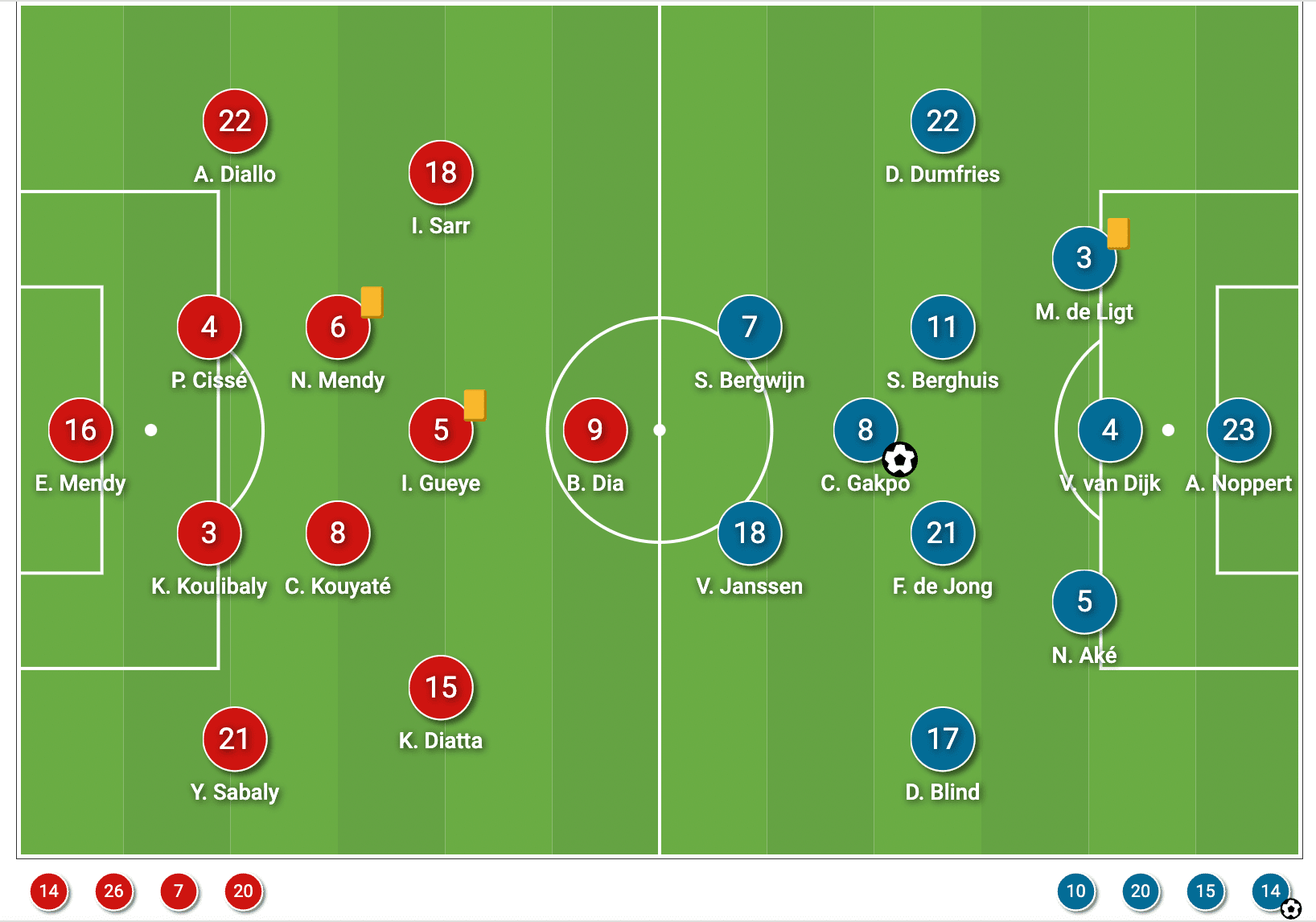
Andries Noppert (203cm/6’8”), on the other hand, was comfortable on his international debut. SC Heerenveen’s gigantic goalkeeper handled the occasion superbly, with the only possible criticism being his reluctance to sweep. It was a brave decision from van Gaal to select the uncapped Noppert, with Ajax’s Remko Pasveer and Feyenoord’s Justin Bijlow also being solid options with a shout to start.
Louis van Gaal made a huge decision in defence, choosing Matthijs de Ligt over Jurrien Timber. In recent international breaks, Timber’s smart tactical versatility has enabled the Netherlands to exert greater control in possession. However, de Ligt was selected to join Virgil van Dijk and Nathan Aké in the Oranje back three. Steven Berghuis was Frenkie de Jong’s midfield partner, another big call from van Gaal which left Atalanta duo Teun Koopmeiners and Marten de Roon to impact off the bench.
Cody Gakpo aimed to continue his phenomenal performances in his new role as an attacking midfielder behind the Netherlands strikers. Gakpo has minimal experience as the ’10’ but has been exceptional in every appearance there under van Gaal. However, like Senegal, the Netherlands were missing their talisman in Memphis Depay. Recovering from injury but proving to be a useful option off the bench, Depay’s exclusion meant two former Tottenham Hotspur players started up top for the Netherlands, with the physically excellent Steven Bergwijn working alongside Vincent Janssen.
The Netherlands man-marking
With the Netherlands’ 3-4-1-2 shape matching up with Senegal’s 4-3-3, a man-marking approach was naturally deployed by both sides. In Senegal’s build-up phase, the Netherlands strike partnership were responsible for cutting the passing lane from the centre-backs into the full-backs. This allowed the Senegalese centre-back duo of Kalidou Koulibaly and Pape Abou Cissé ample time in possession before the ball-side striker would eventually curve his press from out-to-in towards the centre-back.
With the Oranje midfield tightly marking their opponents, the aim was to force Senegal to play direct due to the Dutch defence’s aerial duelling quality. This explains the decision regarding Matthijs de Ligt’s inclusion ahead of Jurrien Timber.
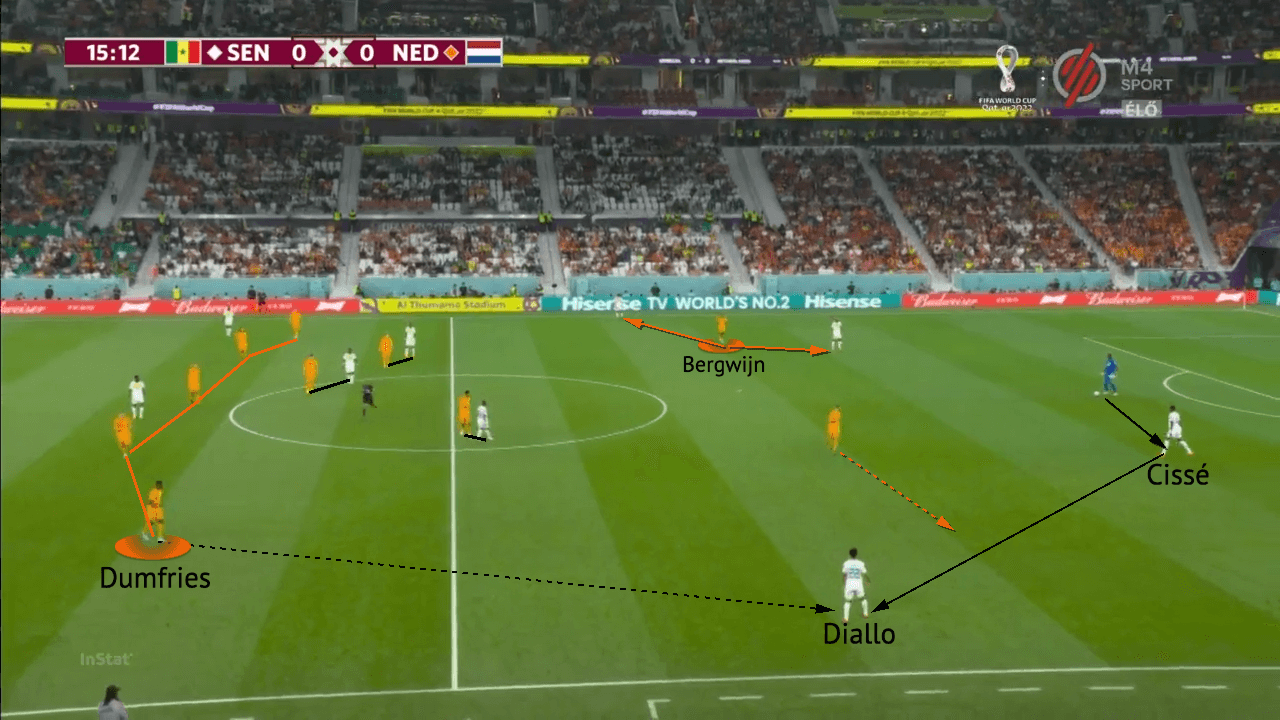
The Netherlands midfield three were reactive out of possession, following their opponent’s every move to fulfil their man-marking responsibilities. Aiming to prevent progression when the Senegal midfielders receive possession, Aliou Cissé occasionally attempted to position his midfield in more advanced areas to combat this. This created situations like the figure above, with an unusual disconnect between defence and midfield.
This has similarities to the UEFA Nations League fixtures between the Netherlands and Belgium, in which Amadou Onana and Kevin De Bruyne would drift wide from central midfield to drag out Dutch midfielders and create space for Eden Hazard to invert. Despite the wide areas being unnatural spaces for Gueye and Kouyaté to occupy, this could have been effective for Senegal to access Ismaïla Sarr between the lines, who had the beating of de Ligt in ground duels with his trickery.
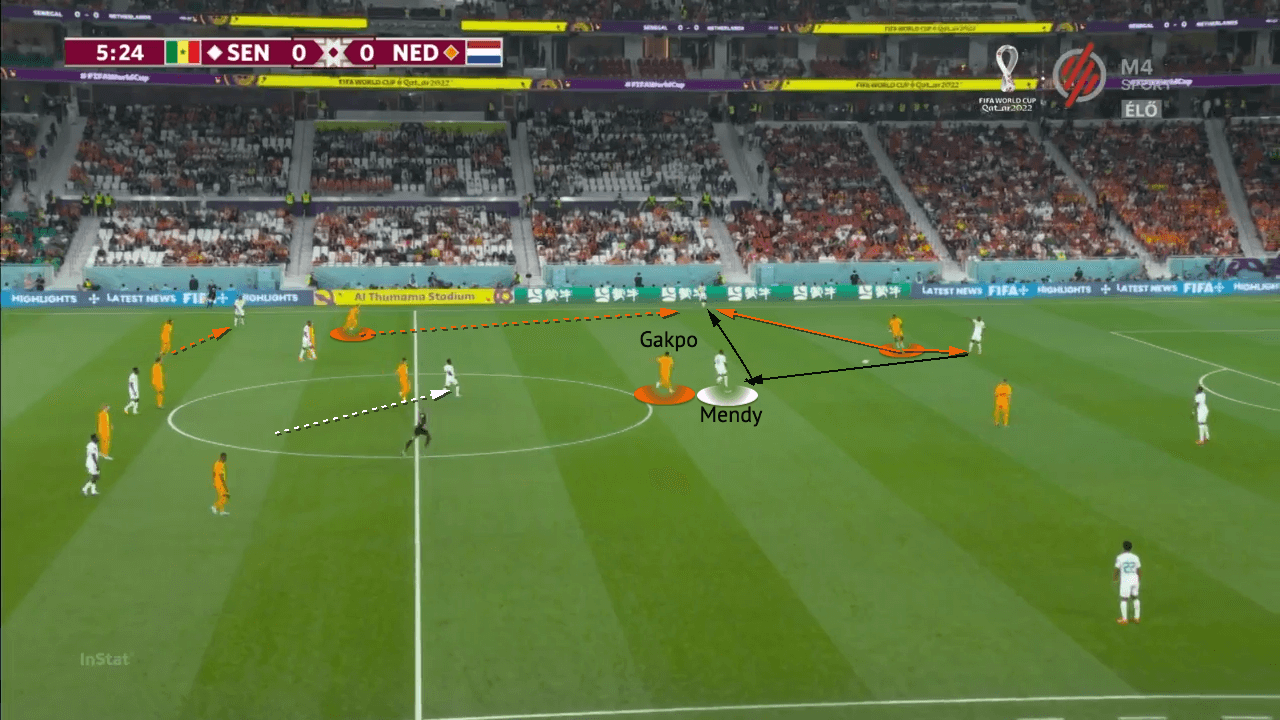
During Senegal’s build-up phase, we would generally see Nampalys Mendy in the pivot space being man-marked by Cody Gakpo. Overall, Gakpo did a commendable job at preventing Mendy from playing forwards, either forcing them backwards or towards the full-back. This would trigger the jump from the Dutch wing-back to sprint out and press the receiving Senegalese full-back.
However, this required the wing-back to sprint a large distance and with Daley Blind lacking in pace, he struggled to apply pressure in comparison to the rapid Denzel Dumfries. This aided Sabaly’s ability to influence Senegal’s attack. With Krépin Diatta’s speed in behind Blind, there was more prominence on Nathan Aké and Virgil van Dijk’s recovery pace when Senegal would look to exploit space. This also relates to de Ligt’s struggles against the super-agile Sarr.
A regular strategy to overcome man-marking systems and progress possession is midfield rotations. With Gueye and Kouyaté both familiar with operating in the pivot space, Senegal was comfortable attempting these exchanges of position. Ajax’s Steven Berghuis was given the dilemma of whether to stay in position or follow his man. Following his man to enact the role of man-marking created larger spaces alongside Frenkie de Jong in the Dutch midfield. However, the Netherlands were generally successful at passing on the rotating midfielder to Cody Gakpo with effective communication.
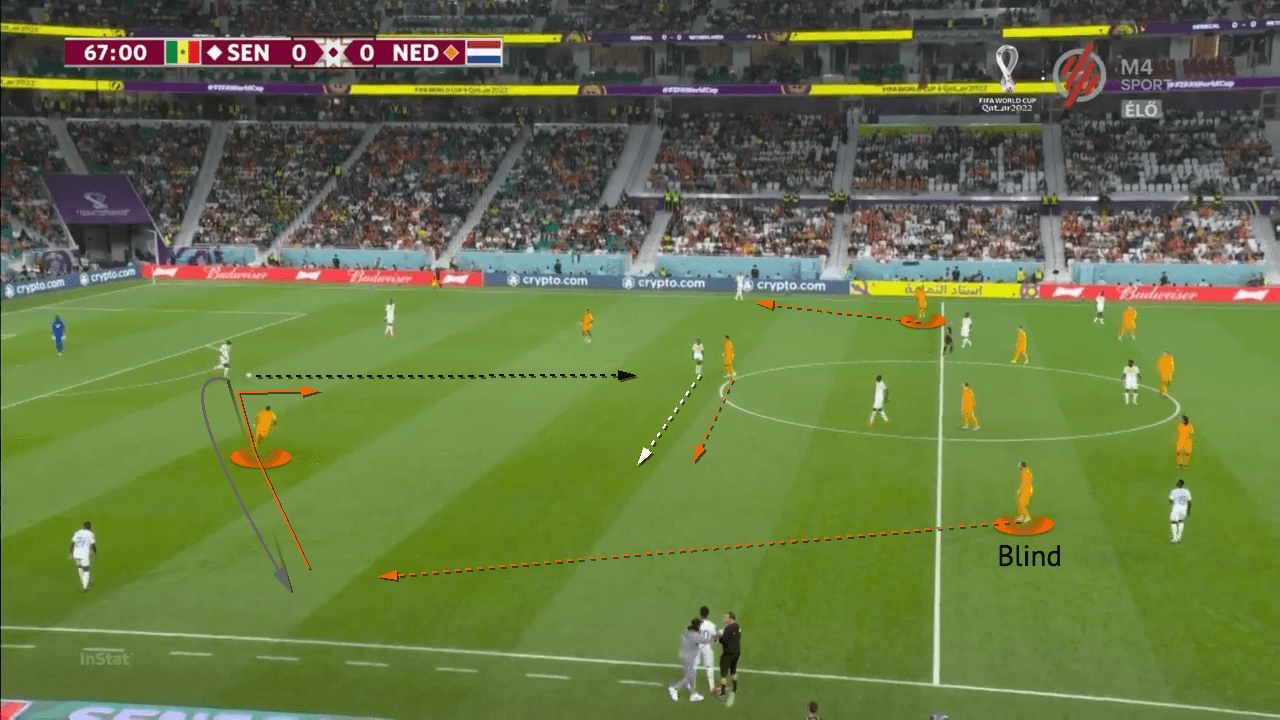
The figure above displays a scenario that Senegal should have looked to exploit more often. With Memphis Depay and Steven Bergwijn positioned to prevent the passes into Senegal’s full-backs, the centre-backs have space to progress possession through dribbling. Although the Dutch strikers will curve their runs to eventually engage the ball carrier, there was potential for Koulibaly to exercise this superiority more. Despite Depay angling his run towards Koulibaly, the Chelsea centre-back could withstand the Dutchman’s challenges.
Nampalys Mendy also played a crucial role in this particular sequence. With Gakpo man-marking the Leicester City midfielder, Mendy drifted away from the centre and Koulibaly’s vertical lane. This attracted Gakpo away from Koulibaly’s route into the opposition’s half and facilitated the centre-backs line-breaking run into the midfield.
Individual quality and movement against man-marking
Man-marking systems create 1vs1 situations all across the pitch and require players to deploy innovative movements to dismark and receive possession, whilst also being technically able to retain and progress possession under pressure. With the shapes of Senegal and the Netherlands naturally matching up to deploy man-marking defensive strategies, this fixture was ultimately decided through individual quality and movement.
Senegal’s midfield mirrored the Dutch set-up with Leicester City defensive midfielder Nampalys Mendy responsible for marking PSV Eindhoven star Cody Gakpo. Idrissa Gana Gueye and Cheickou Kouyaté would look to prevent progression from Steven Berghuis and Frenkie de Jong, whilst Senegal’s full-backs would close down the Dutch wing-backs upon ball reception. By deploying a front three, Aliou Cissé matched up against the Netherlands’ three centre-backs.
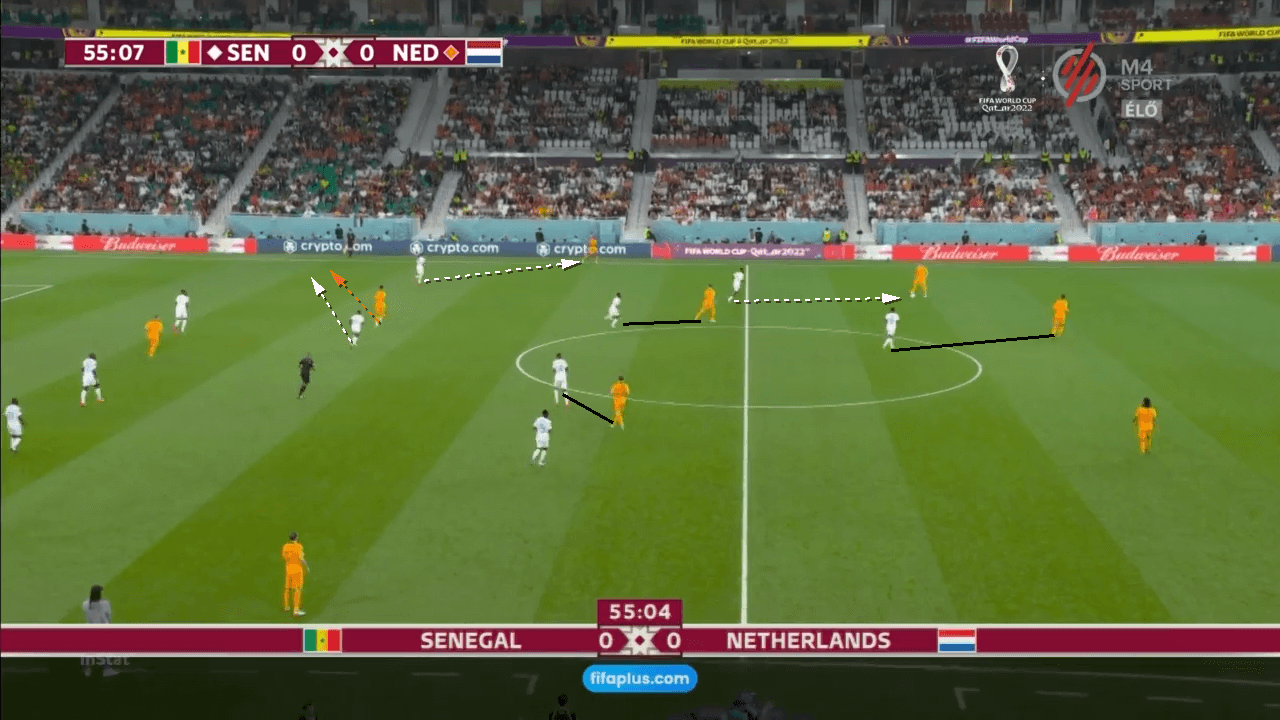
Jurrien Timber’s role on the right side of the Dutch defence requires excellent tactical flexibility and assured technical quality. His movement off-the-ball to step into the midfield or move wide to facilitate Denzel Dumfries advancing up the right wing are vital to the Netherlands’ success in constructing attacks, whilst also being an effective ball-carrier. As Timber’s replacement, Bayern Munich centre-back Matthijs de Ligt was required to provide such versatility. In deeper phases, the Netherlands build up with a back four as Dumfries gallops to join the front line before eventually progressing into a 3-2-5 or a 2-3-5. This demands de Ligt to occupy traditional full-back positions, including inverting, which the defender did not look comfortable with.
Typically, de Ligt’s clunky look in possession would be targeted by the opposition, however, his wider positioning provides a dilemma for Senegal’s winger. With greater distance to cover to engage de Ligt, the Dutchman has time to display his great weight of pass. The Bayern Munich defender can slip a pass behind the closing winger for a central midfielder to receive out of the winger’s cover shadow.
With Dumfries operating as the right width-holder and attracting the Senegal left-back, Oranje could work an effective up-back-through combination with the ball-side central midfielder to release Cody Gakpo or Steven Bergwijn in behind.
However, the situation from the figure above accessed Gakpo more directly. Inter Milan wing-back Dumfries was used as a decoy to attract left-back Abdou Diallo and enlarge the space between the centre-back and full-back for Gakpo to penetrate. Matthijs de Ligt guided a pass into Gakpo’s stride towards the right wing to progress possession into the final third.
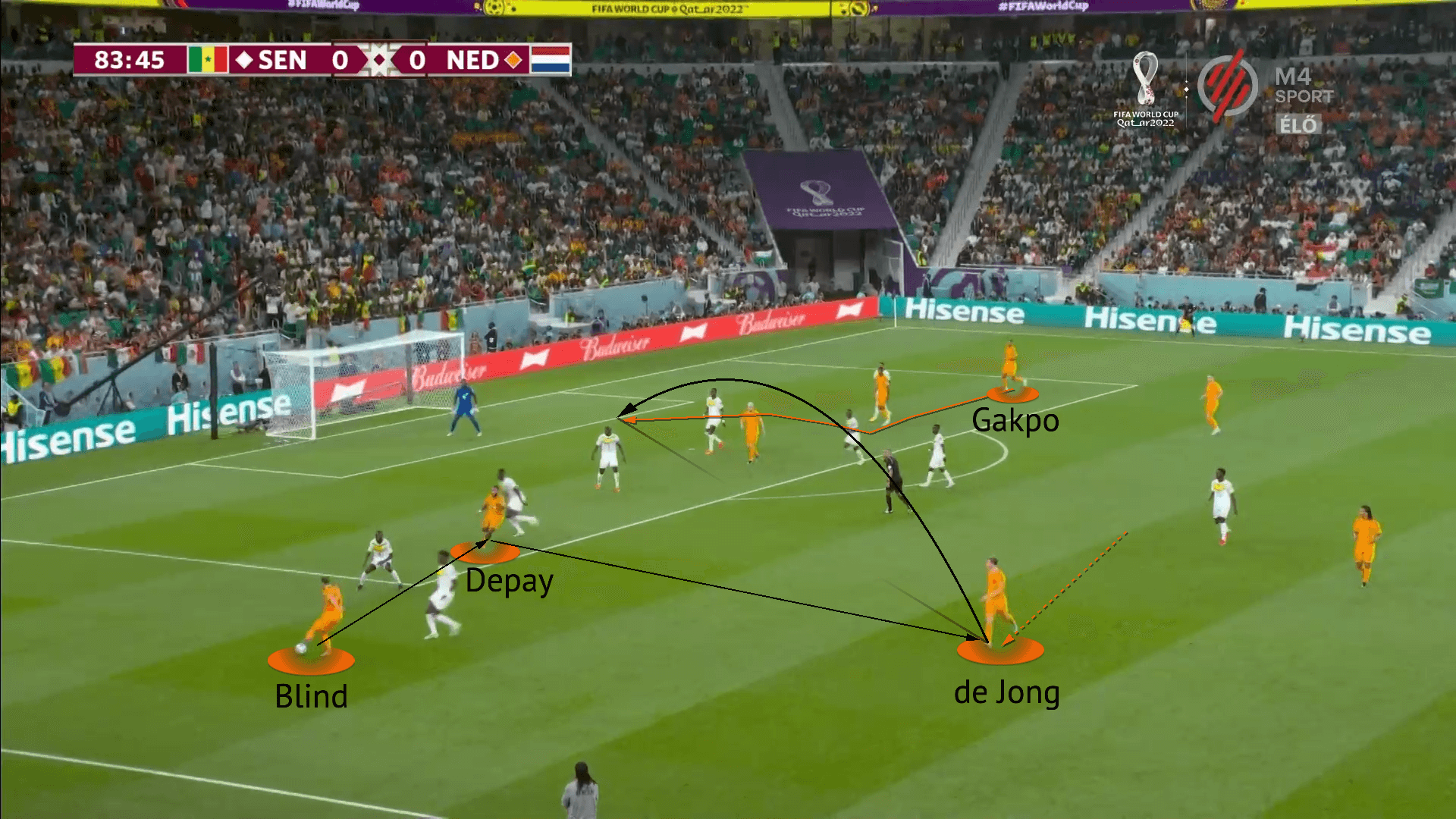
Gakpo’s ability to provide depth and move beyond the strikers behind the opposition’s defensive line is a valuable trait for an attacking midfielder in Louis van Gaal’s Dutch side. Well-known youngster Xavi Simons, a teammate of Gakpo at PSV Eindhoven, can also offer similar movements, but Gakpo’s remarkable physicality and output make him the ideal candidate to operate in the dynamic attack.
His run-making in behind alongside the other fundamentals to succeeding against man-marking opposition was on full display in the Netherlands’ opening goal. After cushioning the second ball down into Daley Blind’s path, the excellent Frenkie de Jong peeled away to provide an option to circulate possession, constantly scanning over his shoulders. Despite pressure from two opponents, Blind remains composed to retain possession and finds the gap to thread the ball into Memphis Depay’s feet. Depay executes a swift double movement to dismark the Senegal defender and make the first-time pass into de Jong.
With time to angle a cross from the left half-space, the world-class de Jong delivers on the biggest stage and finds the superb ghosting run beyond the defence from Cody Gakpo, converting his header past Senegal goalkeeper Édouard Mendy.
Conclusion
With Louis van Gaal setting the Netherlands up in their 3-4-1-2 and Senegal manager Aliou Cissé selecting a 4-3-3, the two sides matched each other up man-for-man, as shown in this analysis. The AFCON champions performed admirably for the first 85 minutes, although they could have been even more aggressive in their pressing until the Man of the Match Cody Gakpo broke the deadlock. Gakpo provided different options and solutions to the challenges Senegal created for the Netherlands with his in-to-out runs towards the right channel helping Denzel Dumfries’ underwhelming attacking influence.
The Inter Milan wing-back performs best when isolated and arriving at the back post with play progressing on the opposite flank, something that frequently happens when Memphis Depay starts. However, with Depay beginning on the bench, Senegal were able to nullify Daley Blind’s impact at left wing-back which in fact led to more ball possession for Dumfries. The right wing-back really struggled to effectively progress and deliver quality, which wouldn’t have been helped by the decision to start Matthijs de Ligt over Jurrien Timber.
Dutchman de Ligt performed a role which he isn’t comfortable with, and although his aerial ability was useful against Senegal’s directness, his ground duels with Watford’s Ismaïla Sarr were challenging.
Sarr and Senegal will be aiming to get back on track by collecting three points against Qatar as they bid to progress out of the group stage and potentially achieve more. Meanwhile, the Netherlands will be looking to secure a place in the knockout stages by overcoming a tough Ecuador side that can threaten van Gaal’s side.

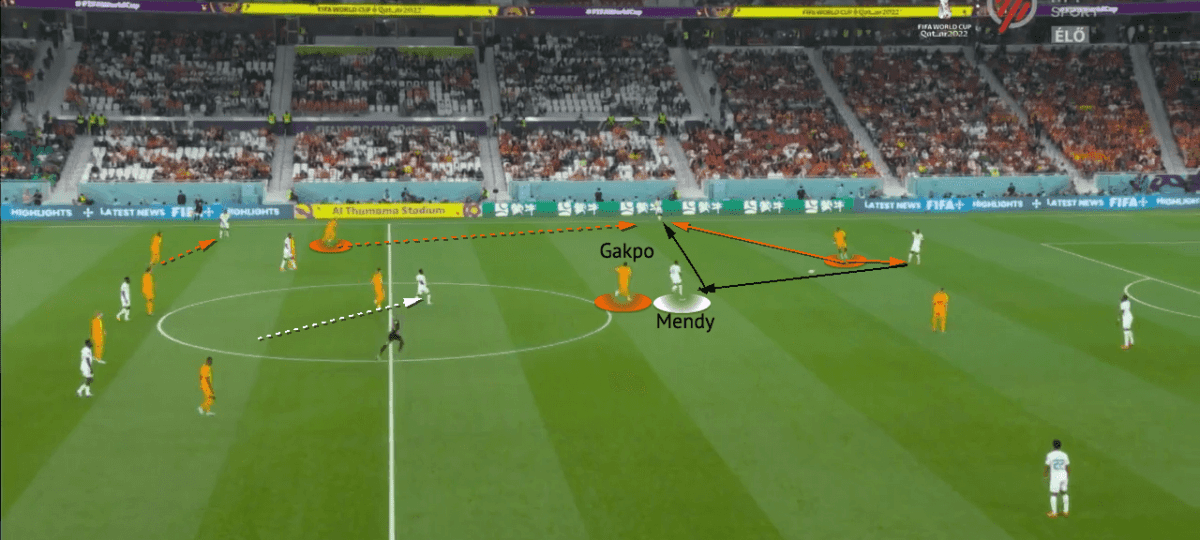




Comments